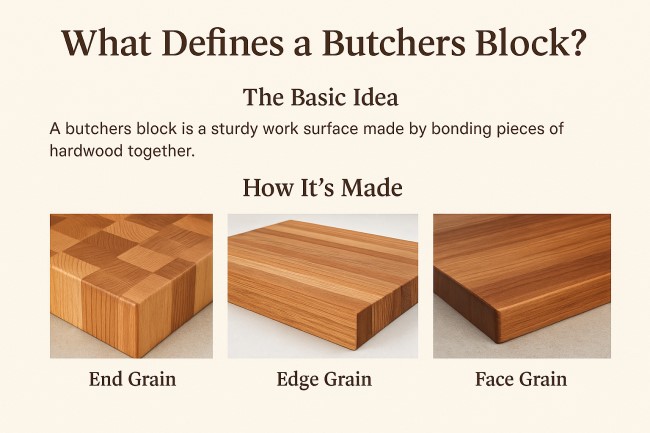Butcher Block Butcher Block: The Ultimate Guide to Wooden Worktops and Boards

Butcher block surfaces have become a favorite in modern homes, rustic kitchens, and workshops alike. Built from assembled hardwood strips, these countertops and boards offer a warm, natural look paired with solid functionality. Whether it’s a classic butchers block chopping board or a centerpiece wooden island, these surfaces blend durability with design.
This guide explores the styles, benefits, maintenance tips, and related products you should know when considering butcher-style wood surfaces for your home.
What Defines a Butchers Block?
The Basic Idea
A butchers block is a sturdy work surface made by bonding pieces of hardwood together. These boards were originally designed for heavy-duty chopping in meat shops but have since evolved into stylish kitchen features and prep spaces.
How It’s Made
End Grain
Wood is cut across the grain and positioned vertically, creating a checkerboard look. This style absorbs knife cuts well and self-heals over time.
Edge Grain
The strips of wood are laid on their sides. It’s a popular, affordable option that provides a neat linear appearance with solid strength.
Face Grain
The widest face of the board is used, giving a smooth and bold grain display. While visually pleasing, this version is softer and best for light use.
Worktops and Countertops
The Rise of Wooden Work Surfaces
Butchers block worktops are increasingly popular among homeowners looking to bring warmth and character to their kitchens. Their clean lines and natural patterns offer a strong visual contrast to metal or stone finishes.
Benefits
-
Natural Texture: A unique organic look enhances any interior.
-
Knife-Friendly: Won’t dull your blades like granite or quartz.
-
Restorable: Minor damage can be sanded and resealed.
-
Budget-Conscious: Generally more affordable than other premium surfaces.
Drawbacks
-
Moisture Sensitive: Needs sealing to prevent water damage.
-
Heat Warning: Hot pots can leave burns if placed directly.
-
Maintenance Required: Needs regular oiling and cleaning.
Islands With Character
A wooden kitchen island with a butcher-style top offers more than just workspace. It serves as a central feature, giving the kitchen a welcoming, functional focal point.
Reasons to Choose One
-
Enhances visual appeal with natural warmth.
-
Adds functional prep or serving space.
-
Supports casual dining or baking.
-
Can be mobile or fixed, depending on needs.
Butchers Block Chopping Boards
Functional & Long-Lasting
Chopping boards built in the butcher block style are ideal for anyone who cooks frequently. These solid boards handle everything from meat to vegetables and are gentle on knives.
Key Advantages
-
Thick and Stable: Won’t slip or shift while cutting.
-
Durable Material: Hardwoods like maple or walnut resist wear.
-
Hygienic Option: Naturally fights off bacteria when properly maintained.
Caring for Your Board
-
Wipe down with a damp cloth after each use.
-
Disinfect using white vinegar or lemon juice.
-
Oil monthly using food-safe mineral oil.
-
Don’t soak or wash in the dishwasher.
What Woods Are Commonly Used?
-
Maple – Very hard and pale, great for kitchen tasks.
-
Walnut – Rich in color and luxurious in feel.
-
Oak – Sturdy and budget-friendly.
-
Acacia – Darker tone, moisture resistant.
-
Beech – Smooth and commonly used in Europe.
Each type of wood brings a different character to the surface. Hardwoods are preferred due to their resistance to cutting, splitting, and staining.
Maintenance and Longevity
Wood surfaces demand attention, but with proper care, they can last for decades.
Daily Tips
-
Clean spills quickly to avoid staining.
-
Don’t use abrasive cleaners or scrubbers.
Monthly Care
-
Apply a thin coat of mineral oil every 4–6 weeks.
-
Buff out scratches with fine-grit sandpaper.
Annual Refresh
-
Lightly sand and reseal for a brand-new appearance.
Comparing Surfaces
| Feature | Wooden Surface | Stone Countertop | Laminate |
|---|---|---|---|
| Warm Aesthetic | ✅ | ❌ | ❌ |
| Knife-Friendly | ✅ | ❌ | ✅ |
| Restorable | ✅ | ❌ | ❌ |
| Moisture Resistance | Moderate (sealed) | High | High |
| Maintenance Level | Medium–High | Low | Low |
Related Terms Explained
Butchers Block
Often used to describe any wood surface designed for food prep, especially heavy cutting tasks. Most commonly refers to freestanding or mounted cutting stations.
Butcher Block
A broader term covering both traditional and modern uses—counters, islands, and tables with glued hardwood pieces.
Butchers Block Worktop
A solid wood countertop, usually edge-grain, used across modern and farmhouse kitchens.
Butcher Block Island
An island counter featuring a thick wooden top, often installed in the center of the kitchen for extra space and visual appeal.
Butchers Blocks
The plural term refers to a variety of wood prep surfaces, from portable boards to large work tables.
Conclusion
Whether you’re seeking charm, functionality, or durability, a butchers block-style surface is a great investment for your kitchen or workspace. While it may need more care than granite or stainless steel, the benefits—natural beauty, repairability, and knife-friendliness—make it well worth the effort.
Use it wisely, maintain it regularly, and this time-honored material will remain a centerpiece in your home for years to come.



